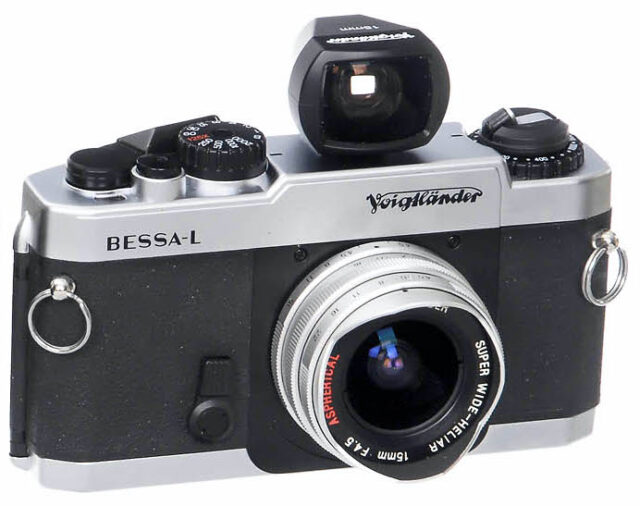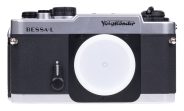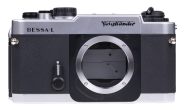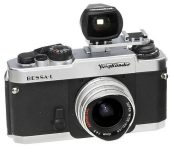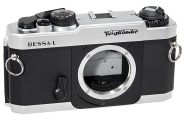Announced
Production status
Cosina Voigtlander BESSA-L
35mm MF film viewfinder camera • Discontinued
Specification
| Format: | |
| 35mm full frame | |
Film type: | 135 cartridge-loaded film |
| Leica screw mount [28.8mm] | |
| Shutter: | |
Type: | Focal-plane |
Model: | Mechanical |
Speeds: | 1 - 1/2000 + B |
| Exposure: | |
Exposure metering: | Through-the-lens (TTL), stop-down |
Exposure modes: | Manual |
| Rangefinder and Viewfinder: | |
Rangefinder: | - |
Viewfinder: | Accessory |
| Physical characteristics: | |
Weight: | 320g |
Dimensions: | 135.5x78.5x33.5mm |
Manufacturer description #1
In 1952, Ike was elected President, Lucy and Ricky were ducking custard pies on TV every week, and Mickey Mantle was stepping up to the plate for his second full season in the Big Leagues. Glorious times for all, for sure, but especially for average American photographers who, for the first time, were discovering in great numbers the possibilities and powers of 35mm cameras. Names like Leica, Nikon, and Canon were gaining a foothold in our collective subconscious thanks to the reliability, functionality and elegance of those cameras. Chief among them? Voigtlander, a camera maker and optical company from Braunsweig Germany founded in 1756, whose first interchangeable-lens 35mm rangefinder, the "Prominent", had reached American shores to great acclaim that year. Throughout the Fifties and Sixties, the Voigtlander 35mm's became synonymous with faultless operation, and elegantly styled 35mm rangefinders and SLRs capable of superb pictures.
Now almost thirty years later, the Voigtlander name is back. Resurrected by the Japanese, Voigtlander is back with a unique and different 35mm wide-angle camera, the beautiful Bessa-L. Fully restoring the Voigtlander claim to fine photography, the Bessa-L features the retro styling and flawless operation of earlier Voigtlanders, but it's a distinctly 1990's camera with all the advantages that modernity brings: lightweight, simplicity, superb imaging and, yes, affordability.
What is the Bessa-L? It's like no 35mm camera you've every experienced. Is it an SLR? No. The Bessa-L has no reflex mirror and no roof prism viewfinder. Then it must be a 35mm rangefinder camera like a Leica M6, right? No, it's totally scale focusing, with no built-in rangefinder to add costly optics and mechanics. There's not even an integral viewfinder. Well then it must be a point-and-shoot-type 35mm with an in-lens leaf shutter, right? Wrong again. The Bessa-L uses a focal-plane shutter like the most sophisticated 35mm's.
Well, if it's not an SLR, a rangefinder or a point-and-shoot, was IS the Voigtlander? Answer: a scale-focusing, interchangeable lens, interchangeable viewfinder camera that most resembles the classic 35mm rangefinders of the 1940's and '50's. Its strength? Wide angle photography. Voigtlander offers two lenses for the Bessa-L, and one of them, the 15mm f/4.5 Super-Wide Heliar Aspherical, is probably the widest lens ever made for a non-SLR 35mm camera. But that's not all. It's amazingly compact, shockingly sharp using aspherical elements, and most importantly, it's practically distortion free. Because the Voigtlander engineers didn't have to design the Heliar to work with a reflex mirror, the lenses are smaller, sharper and with much less distortion than you'll find in comparable SLR optics. Now ultra wide angle photography is yours without the tell-tale distorted lines commonly found in most ultra-wide angle shots.
The second lens? An equally sharp 25mm f/4 Snapshot-Skopar, perfect for more general photography. Both lenses sport conveniently click-stopped aperture rings, with distance scales color coded for meters and feet. The distance scale on the 25mm f/4 Snapshot-Skopar is nicely click stopped at 1, 1.5 and 3 meters, making it possible to focus without removing your eye from the finder.
Styled with a distinctly retro look, the Voigtlander appears, at first glance, to be an expensive collectible from the 1950's. But as beautiful as the Bessa-L is to behold, it's even MORE beautiful to hold. Its rubberized matte-black outer covering is easy on the fingers, and the camera body is much more grippable, and much less heavy than the old-style rangefinders thanks to its sturdy, but light weight, die-cast all-aluminum body. You'll find the Bessa-L compact and easily balanced in two hands, with the controls falling immediately under appropriate fingers. The shutter release is smoothly arced, easily accessed for fast and responsive shooting, and it's conveniently threaded to receive a standard cable release. For flash operation, the Bessa-L offers a PC terminal and a 1/125 second top flash synch speed. Other amenities include a bottom-plate tripod socket, a 10-second self-timer, and depth-of-field scales on both lenses.
The Bessa-L delivers dead-on exposure using a TTL, center-weighted averaging meter whose readings appear on the top of the camera, fully visible with your eye at the viewfinder. Three brightly-lit meter LEDs (red arrows and a green circle) tell you which direction to turn the aperture ring for the perfect reading.
Perhaps the most unusual Voigtlander trait? No built-in viewfinder. The camera does without the complicated viewing systems required by most 35mm's. There's no reflex mirror flapping around, for example, clattering noisily with every shot. No mechanical rangefinder vulnerable to failure. The Bessa-L's interchangeable viewfinders slip easily on and off (but not so easily that they'll fall off), and their images are clear, bright, contrasty and free of etched framing lines or other unnecessary clutter.
The Voigtlander's simple thumb-activated, single-stroke film advance is much quieter and also less vulnerable to mechanical problems than motordrives that stop dead as soon as the batteries die. That's right: everything except the meter will work if the Bessa-L's batteries run down. Try THAT with your $2000 high-tech SLR!
Are you tired of digital this and auto that? The Voigtlander is your camera. The Bessa-L is an instant classic and certain to achieve cult-camera status, as aesthetically sophisticated as it is electronically simple. Perhaps the most exciting thing about the Voigtlander Bessa-L? Nostalgia fans can use the body as the central building block for reconstructing an affordable and reliable system using lenses and viewfinders made for cameras back in the 1940's and '50's. Its L-mount threaded lens mount accepts optics made for all the famous-name rangefinder cameras that are still to be found on the pre-owned market, plentiful and often inexpensive. You can mix and match lenses and accessory viewfinders to build your own hybrid classic with elements from the glory days of 35mm. It's as close as many of us ever come to owning a vintage Leica.
The Bessa-L brings back the glory days of 35mm photography affordably. Are you as hung up on elegance and style as you are on performance? The Voigtlander Bessa-L is an instrument that looks as good as it shoots. Sleek lines, beautiful curves, deco-inspired design. Check it out today at your local camera dealer, and learn why the camera has already taken Japan by storm.
Learn why, with Voigtlander, it's easy to fall in love with pictures again.
Manufacturer description #2
The BESSA was once the cornerstone of precision photographic engineering. After an absence spanning several decades, the Bessa has returned as a dedicated wide-angle viewfinder camera.
BODY
The Bessa-L is composed of an all aluminum die-cast metal casing with a streamline body that fits comfortably into the palm of your hand making it a paradigm of design simplicity. It is lightweight, precise, and extremely durable with excellent corrosion resistance. This camera offers precision and reliability under all photographic conditions.
SHUTTER
The unique double mechanical shutter is a combination of a mechanically controlled focal plane shutter that can operate up to 1/2000 of a second and a newly developed light-shielding shutter. Reliability of these mechanisms is very high; meaning, the photographer no longer has to keep a lens cap over the front or keep the lens set at a small aperture to avoid the possibility of stray light damaging the film.
The BESSA-L features manual lever operated film winding and simple manual film rewinding. In addition, the camera has a highly responsive photographing speed with a pleasantly quiet shutter sound.
TTL
Through the lens (TTL) center-weighted light metering, measures light reflected from the shielding shutter with a photo receptor device (silicon photocell) on the base of the body. Pressing the shutter button halfway activates the light measuring circuit. LED lamps at the rear of the camera display whether the correct exposure has been selected. The LED lamps are positioned at the lower left of the viewfinder, allowing the exposure accuracy to be checked without the user taking their eye away from the viewfinder.
L-MOUNT
The Bessa-L is equipped with a highly compatible 39mm L-screw mount system used for interchanging lenses. The ability to attach to other L-screw mount wide-angle lenses from Leica and Canon makes it an even more unique and versatile camera.
Light metering can be performed with most L-screw mount lenses, but TTL light metering can not be performed with lenses having extremely short back-focus.
Manufacturer description #3
Type: 35mm camera with focal plane shutter and TTL metering system.
Shutter: Vertically moving metal focal plane shutter B, 1-1/2000 sec.
Self-Timer: Mechanical self-timer with 10 sec operating time.
Exposure display: Over exposure warning, Good exposure warning, Under exposure warning.
Exposure Metering System: Center-weighted average metering. By pressing Shutter Release Button.
Exposure Coupling Range: EV4-19 (ISO 100, F4, 1sec.-F16, 1/2000sec.).
Flash Terminal: X synchro contact synchronized at 1/125 sec or lower speed.
Film Advance: By single-lever action with 135 deg. throw and 30 deg. stand-off.
Film Rewind: By film rewind button and film rewind crank.
Frame Counter: Additive type with autoreset by opening the back cover.
Film Speed Range: ISO 25-1600 by 1/3 steps.
Power Source: Two 1.5V Alkaline batteries (LR44) or Silver batteries (SR44).
***
This is lens-interchangeable super wide-angle camera with TTL exposure metering function. The camera is lens interchangeable via L-mount, yet is lightweight and compact. Attaching 15mm/f4.5 or 25mm/f4 lens onto this camera, you can enjoy easy-to-take snap-photography, landscape, etc.
From the Classic Camera magazine (August 1999)
After an absence of some thirty years, Voigtlander cameras are back in production with a revival of a famous name in a rangefinder style camera, with interchangeable lenses, called the Bessa-L. The German owners of the Voigtlander trade-mark have licensed the manufacturer of the new camera, Cosina, in Japan, to use the name and produce the camera to their specifications.
Although the new camera is referred to as a rangefinder style model it is not, in fact, fitted with a rangefinder, but uses separate direct vision clip on viewfinders which are supplied with the two currently available wide-angle lenses, a 15mm ultra wide plus a 25mm. Both lenses will, no doubt, be sought after by Leica enthusiasts as they are made in Leitz screw thread and are available for sale independently.
The 15mm lens is a fully corrected Super Wide Heliar f4.5 Aspherical, which comprises of 8 elements in 6 groups. It covers and angle of view of 110 degrees and focuses down to 0.3m. The diameter is 49.6 mm with a length of 30.7mm and it weighs 33gm. The second lens is a 25mm f4 Snapshot Skopar which is made up of 7 elements in 5 groups. The closest focusing distance is 0.75m. The lens is 46.5mm in diameter and 29.5mm long with a weight of 30gm.
The camera body is constructed with an aluminium die-cast frame which gives both ightness and strength. The dimensions are: 135.5mm wide x 78.5mm high x 33.5mm deep and the weight is 320 gm. The camera is fitted with a vertical running, metal bladed focal plane shutter with speeds from 1 sec. to 1/2000 sec. plus B and an X sync. setting of 1/125 sec. The front curtain has a pattern to read the TTL, centre weighted exposure readings, which are set manually via the red and green LED panel which is on the rear panel of the camera adjacent to the position of the viewfinder shoe. Left and right red LED's indicate under/over exposure, with a central green one to show the correct setting. The exposure meter has a range of EV4 to EV 19 with ISO 100 film. The film speed setting range is from ISO 25 - 1600. Film advance is by a single stroke of 135 degrees with a 35 degree stand-off position. A self timer giving a 10 second delay is fitted but there is no shutter release lock or provision for double exposures to be made.
From the Classic Camera magazine (November 2000)
It is often said that you can never turn back the clock. This may be true in love, sports and business, but with photography it would appear that it is sometimes possible. The Bessa L, the camera recently released on the market under the Voigtlander trademark but manufactured by Cosina, brings back to life something from the past we thought had been lost, something cherished by classic camera devotees, starting with the name itself, one of the oldest in photographic history.
The Braunschweig name, associated especially with lenses, has remained in the hearts of collectors who mourn the delicate, three-dimensional optical results and the construction of such famous lenses as the Heliar, Skopar and Nokton. Collectors are not interested in this new camera for the Voigtlander name alone, but also for the very traditional features of the camera itself and the lenses that come with it.
The main feature of the Bessa L that places it squarely in the ranks of classic cameras, even those of recent construction, is the 39x1mm thread gauge of the lenses, i.e., the traditional Leica gauge par excellence, adopted for years by many cameras around the globe. This means that the Bessa L can make use of the hundred or so lenses with this mount that have been produced under various brand names for at least fifty years. In reality, the selection narrows to just wide-angle lenses because the Bessa L is not equipped with a rangefinder and for lenses with focal lengths greater than 50mm, focusing becomes difficult and must be calculated using the metric scale.
For wide-angle lenses with 35mm focal length or less, focusing is facilitated by the very wide depth of field and use of the hyperfocal distance. But even with these potential limitations, there is still a vast selection of German, Japanese and Russian lenses (as well as other nationalities) for the Bessa L. The camera comes equipped with two super wide-angles and a regular wide- angle plus a 50mm and 75mm telephoto, but the wide-angle lenses with 15mm, 25mm and 35mm focal lengths remain the most interesting.
The Bessa L is constructed of light aluminum die-cast metal, weighs just 350 grams and has a mechanical shutter with speeds up to 1/2000, B setting and flash synch times of 1/125.
Exact exposure is indicated using a TTL exposure meter powered by two 1.5 volt batteries with three colored LEDs located on the back of the camera at the left close to the finder clip. This makes it possible to check exposure accuracy while framing the shot. The exposure meter with center-weighted average metering is activated by pulling the winding lever slightly away from the camera body and the film speed is adjusted using a dial located on the left of the top plate. On the front of the camera is the mechanical shutter release lever. The shutter is made up of vertically-moving metal blades with low vibration and characteristic sound.
Not only is it not equipped with a rangefinder, the Bessa L does not even have its own viewfinder. For this reason, depending on the lens being utilized, the corresponding finder must be mounted on the accessory clip. It gives the impression of going back in time forty or fifty years, to the days of the screw Leica or Contax, when each lens had its own viewfinder.
For some aspects - such as its extremely light weight, the rewind crank or shutter release button - the camera almost seems a toy. The film advance lever must be used with care to avoid tearing the film perforation which would cause double-exposure of the frames. Not having been designed in the style of a miniature tank, the Bessa L gives the impression of requiring a certain amount of care and attention, but in reality it is well-built and extremely functional. The lens mount is of all-metal construction and very sturdy. Only constant, regular use will tell how reliable the Bessa L is.
The camera body and lenses come in either black or chrome finjsh, the latter recalling that of the timeless cameras of the '50s and '60s, while the viewfinders are only available in black.
The wide-angle lenses available are the 15mm f/4.5 Super Heliar, 25mm f/4 Skopar and 35mm f/1.7 Ultron. Despite the German name, all lenses bear the "Made in Japan" inscription, in line with the normal practice of other photographic companies. Screw mounting of the lenses is not overly fast, requiring several seconds but not more than five.
The viewfinders have a very elegant external plastic finish. The 15mm one has a pronounced barrel-like shape which can prove annoying on some occasions, but the 25mm finder seems much more normal. Each finder weighs approximately 30 grams. The Bessa L equipped with the 15mm and corresponding finder does not exceed 500 grams, truly a record for such a combination.
The 15mm sports the marking "Aspherical" in red, indicating that aspherical elements have been used in the optical design and it has eight elements in six groups for a total weight of barely 100 grams. There has never been such a light-weight wide-angle lens. The barrel in light-weight metal with elegant silver finish recalls the style of 1950s lenses. The minimum focusing distance of just 30 centimeters, together with the very wide depth of field, assures good resolution in every corner of the photograph.
The 25mm Skopar has seven elements in five groups for a total weight of just 90 grams and its mount is equipped with a lever to facilitate maneuverability of the focusing ring. The minimum focusing distance is 70cm and the lens comes equipped with a small screw shield to keep fingers out of the frame. In fact, as in all non-reflex cameras, it is quite easy for a stray finger or two to remain too close to the front lens element during focusing or shooting, creating unpleasant surprises in the finished print or transparency.
The 35mm f/l.7 Ultron is composed of eight elements in six groups and also utilizes an aspherical element as evidenced by the red marking on the front of the lens. It weighs 200 grams and is considerably bulkier than the other two wide-angle lenses. Like the 25mm, the Ultron has a small light shield, also useful in keeping unwanted fingers out of the picture. None of the super wideangles has a rangefinder coupling mechanism and when utilized with any other type of camera, focusing must always be estimated based on their enormous depth of field plus increasing the closure of the diaphragm and judicious use of the hyperfocal. The resulting images will always be crisp and in-focus.
These new Voigtllinder lenses came as a true surprise to collectors of this brand. The lenses are extremely compact, amazingly light and offer more-than-satisfactory results in each focal length, especially the 15mm. They do not create problems of weight and permit complete freedom of movement without creating guilt complexes over exorbitantly high prices or use of too-conspicuous brand names in the midst of the crowd.
In terms of weight and focal length, the 35mm could be considered a virtually normal lens, even if its relative speed is noteworthy. In the field, these lens - so small in size and so relatively low in cost - do not perform badly at all. The results obtained from the three lenses are relatively similar with better-than-average sharpness but evident distortion at the edges of the shot that is even more noticeable with the 15mm. With this lens, the distortion of the dedicated viewfinder often hinders correct framing and, added to the visible distortion of the lens at the edges of the photograph, this can easily cause photos with straight lines that are accentuated and noticeably curved at the edges, not the best thing for architectural photography made even more difficult by the lack of a bubble level on the camera body or viewfinder. Given the extremely competitive prices of these lenses, we cannot help but be amazed by the excellent overall quality and color balance.
With its simplified design without viewfinder or focusing system, the Bessa L offers the option of a very economic camera with immediate and universal applications. It could be an alternative, modern, camera body equipped with TTL exposure meter on which to utilize the wide range of used screw-mount lenses available on the market. The release of the 50mm f/1.5 Nokton Aspherical and 75mm f/2.5 telephoto lenses would seem to provide indirect confirmation of a future version of the Bessa L equipped with view- and rangefinder.
The allure of the classic Voigtlander inscription engraved on the front of the Bessa L and faithfully repeated on the lens caps should not be underestimated. With a certain amount of nostalgia, it takes us back to the excitement of our first photographic experiences when this brand name was the point-of-reference for all those entering the world of photography.
Special editions (1)
- Cosina Voigtlander BESSA-L "HELIAR 100 Years Limited Edition" (500 units) - 2000
Similar cameras (6)
35mm full frame • Manual focus • Film • Viewfinder • Leica screw mount mount
| Model | Shutter | Metering | Modes | Year |
|---|---|---|---|---|
| Leica I (Model C) | M, 1/500 | -- | M | 1930 ● |
| Leica Ic | M, 1/500 | -- | M | 1949 ● |
| Leica If | M, 1/500 | -- | M | 1952 ● |
| Leica Ig | M, 1/1000 | -- | M | 1957 ● |
| Leica Standard (Model E) | M, 1/500 | -- | M | 1932 ● |
| Zarya aka Заря |
M, 1/500 | -- | M | 1959 ● |
